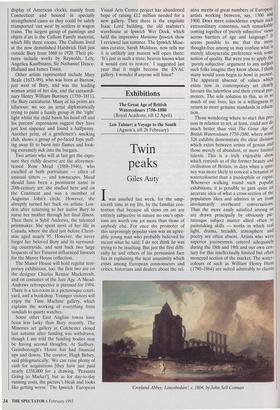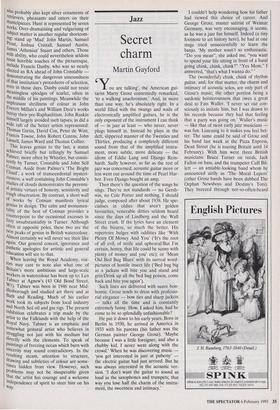Exhibitions
The Great Age of British Watercolours 1750-1880 (Royal Academy, till 12 April) Len Tabner: a Voyage to the South (Agnew's, till 26 February)
Twin peaks
Giles Auty
Iwas assailed last week, for the ump- teenth time in my life, by the familiar con- tention that because all views on art are entirely subjective in nature no one's opin- ions are worth one jot more than those of anybody else. For once the promoter of this surprisingly popular view was an agree- able young man who probably believed he meant what he said; I do not think he was trying to be insulting. But just the first diffi- culty he and others of his persuasion face lies in explaining the near unanimity which exists among European connoisseurs and critics, historians and dealers about the rel- ative merits of great numbers of European artists working between, say, 1300 and 1900. Does mere coincidence explain such extraordinary consensus, such remarkable coming together of 'purely subjective' views across barriers of age and language? It seems possible to me that the more thought-free among us may confuse what is merely idiosyncratic preference with some notion of quality. But were you to apply the `purely subjective' argument to any subject such folks imagine they know about, I think many would soon begin to howl in protest. The apparent absence of values which exists now in contemporary art clearly favours the talentless and their critical pro- moters. The sole solution to this, as in so much of our lives, lies in a willingness to return to more genuine standards in educa- tion.
Those wondering where to start this pro- cess in relation to art, at least, could not do much better than visit The Great Age of British Watercolours 1750-1880, where some 326 exhibits demonstrate the clear division which exists between artists of genius and those merely of abundant, or more limited talents. This is a truly enjoyable show which reminds us of the former beauty and civilisation of Britain, in days when a spin- ney was more likely to conceal a botanist or watercolourist than a paedophile or rapist. Whenever walking round such popular exhibitions, it is possible to gain quite an accurate idea of what a cross-section of the population likes and admires in art from involuntarily overheard conversations. Thus the more easily satisfied among us are drawn principally by obviously pic- turesque subject matter allied often to painstaking skills — works in which real light, drama, breadth, atmosphere and poetry are often absent. Artists who were superior journeymen catered adequately during the 18th and 19th and our own cen- tury for this intellectually limited but often moneyed section of the market. The water- colours of such as William Henry Hunt (1790-1864) are suited admirably to clients `Croyland Abbey, Lincolnshire, c. 1804, by John Sell Cotman who probably also kept silver ornaments of retrievers, pheasants and otters on their mantelpieces. Hunt is represented by seven Works. Over-dramatising and vulgarising of subject matter is another regular shortcom- ing: stand up 'Mad' John Martin, Samuel grout, Joshua Cristall, Samuel Austin, James 'Athenian' Stuart and others. Those with ability, who could nevertheless seldom resist horrible touches of the picturesque, include Francis Danby, who was so nearly elected an RA ahead of John Constable demonstrating the dangerous unsoundness of that institution's procedures of selection, even in those days. Danby could not resist meaningless splodges of scarlet, often in the middle of his paintings. Meanwhile the unpleasant shrillness of colour in John Everett Millais's and William Dyce's works betray their pre-Raphaelitism. John Ruskin himself largely avoided such lapses, as did a wide raft of the better artists represented: Thomas Girtin, David Cox, Peter de Wint, Francis Towne, John Robert Cozens, John Linnet], James Ward and Thomas Collier.
This leaves genius to the last, a status achieved briefly but tellingly by Samuel Palmer, more often by Whistler, but consis- tently by Turner, Constable and John Sell Cotman. Aside from Palmer's 'The Bright Cloud', a work of transcendental mysteri- ousness, a wall containing John Constable's studies of clouds demonstrates the perenni- al artistic virtues of honesty, sensitivity and tough observation. By contrast, a short wall of works by Cotman manifests lyrical genius in design. The calm and monumen- tality of the best of Cotman provides a counterpoint to the occasional excesses in Fly unsubstantiality in Turner. Although often at opposite poles, these two are the h‘'In peaks of genius in British watercolour. Almost certainly we will never see their like again. Our general conceit, ignorance and Pathetic apologies for artistic and general education will see to that.
When leaving the Royal Academy, visi- tors may care to note also what one of Britain's more ambitious and large-scale workers in watercolour has been up to: Len Tabner at Agnew's (43 Old Bond Street,
Tabner was born in 1946 near Mid- dlesborough and studied art there and at Rath and Reading. Much of his earlier Work took its subjects from local industry and North Sed oil and gas rigs. The present exhibition celebrates a trip made by the artist to the Falklands with the help of the Royal Navy. Tabner is an emphatic and somewhat gestural artist who believes in struggling not just with his medium but directly with the elements. To speak of Paintings of freezing ocean which burn with sincerity may sound contradictory. In the resulting steam, attention to structure, drawing and subtleties of colour are some- tunes hidden from view. However, such Problems may not be insuperable given that the artist has courage and a welcome independence of spirit to steer him on his way.























































 Previous page
Previous page